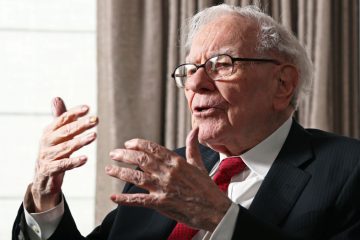Things You Didn’t Know About Buffett’s Strategy
Last weekend I spent a couple hours reading through Buffett’s old partnership letters (again). I was looking for something specific that I remembered him talking about, but then as I was flipping through them trying to find this comment, I just decided to read them again. I’ve always found it extremely valuable to read Buffett’s letters. Although I’ve read both the partnership letters and the Berkshire letters multiple times, I feel like I pick up something new each time I read them, or maybe I notice something helpful or relevant to a particular investment situation I’m currently working on.
I think the best way to learn and improve as an investor is by doing it—just invest. You learn a lot by reading about companies and researching situations. The second best thing you can do outside of investing itself is by reading and reverse engineering case studies. There aren’t many in the Buffett letters, but there are a few. (I found it interesting that he lists an oil stock arbitrage in an appendix to the 1963 letter, and discusses how it was very profitable to invest in merger arbitrage deals during that time—Buffett would buy stocks of smaller oil producers that were selling out to the larger integrated oil majors, with the objective of making 20% annualized returns on the investment operations).
Anyhow, maybe I’ll review a case study or two some other time. For now, I wanted to write a post with a few comments that Buffett made in those early letters that were thought provoking. Another thing for me personally, I think the partnership letters are interesting because Buffett was operating with a much smaller sum of capital, and was engaging in investment operations that were much different than he engaged in even a decade or two later at Berkshire.
For instance, he was managing $ 4 million in 1961, which was a small sum even then (however, it was large enough for Buffett to engage in activist investment operations even back then).
A good friend and I have considered writing a series of posts, or some sort of compilation at some point discussing these letters, but for now, here are just a few clips that made me think while flipping through them over the weekend.
1962 Letter
Buffett talks about his strategy here. I’ve always liked his approach to categorizing investment ideas. Although I’ve said before that I don’t seek out investments in any specific category, I do think it helps to know which investment idea belongs in which category—but the horse has to come before the cart (seek out value first, not categories of investments). As far as Buffett is concerned, he described his approach in the 1961 letter. I might summarize his portfolio strategy in a separate post, because I think it is generally misunderstood by the casual investing public, especially in the early years.
In the 1962 letter (and most letters thereafter), he briefly summarizes his portfolio strategy:
“Our avenues of investment break down into three categories. These categories have different behavior characteristics, and the way our money is divided among them will have an important effect on our results, relative to the Dow in any given year. The actual percentage division among categories is to some degree planned, but to a great extent, accidental, based upon available factors.”
I’ll go into more detail in another post, but he lists his three categories of investments as:
- Generals—plain vanilla investments in stocks that are undervalued without any specific catalyst
- Workouts—special situations such as merger arbitrage, spinoffs, etc…
- Controls—investments where Buffett became the largest or majority shareholder and pushed for change (a category that would now be referred to as activism).
Buffett and the Activist Put
Since the title of this post is “Things You Didn’t Know About Buffett”, here is the first comment I jotted down that I hadn’t noticed before (the title is presumptuous… maybe you did know!). Buffett, when discussing the general investment category said this:
“Many times generals represent a form of “coattail riding” where we feel the dominating stockholder group has plans for the conversion of unprofitable or under-utilized assets to a better use. We have done that ourselves in Sanborn and Dempster, but everything else equal, we would rather let others do the work. Obviously, not only do the values have to be ample in a case like this, but we also have to be careful whose coat we are holding.”
This sounds like what has recently been referred to as the “activist put”. Basically, a large shareholder takes a stake in a company and announces the “changes” they’d like to see (usually, it’s something really creative like loading the company with debt to buy back stock in the name of “unlocking shareholder value”). Investors who believe in the merit of this “activist put” will then invest in this company under the assumption that if things get better and operations improve or the stock price rises, great… if the stock price falls, then the activist will buy more and continue rattling the cage until things do improve. The theory is that this creates a floor (or “put”) under the price.
I’ve never been a big fan of such a strategy, and I wouldn’t make an investment decision that is founded on this type of theory. But I do understand that in reality this type of situation exists. Heck, there was even talk of a “Buffett put” a year or two ago when Buffett announced he would buy back stock at 1.1 (later increased to 1.2) times book value.
So the activist put can be real—I just wouldn’t make it a primary reason for being interested in an investment. And as Buffett says, value has to be present, and probably most importantly when evaluating the activist put is to “be careful whose coat we are holding”.
Using Borrowed Money
The second thing that some people might not have known is that Buffett used borrowed money in his partnerships. He didn’t borrow a lot, and he didn’t borrow against the “general” investments, but he did use leverage when investing in special situations, or “workouts” as he called them.
Buffett describes workouts as “securities whose financial results depend on corporate action rather than supply and demand factors created by buyers and sellers of securities… Corporate situations such as mergers, liquidations, reorganizations, spin-offs, etc… lead to workouts.”
He describes the benefits of investing in these special situations:
“This category will produce reasonably stable earnings from year to year, to a large extent irrespective of the course of the Dow. Obviously, if we operate throughout the year with a large portion of our portfolio in workouts, we will look extremely good if it turns out to be a declining year for the Dow or quite bad if it is a strongly advancing year.”
So the workouts provide, as the portfolio academics would say, uncorrelated and attractive risk-adjusted returns. While any one deal could go sour, a basket of these investments over a period of time would provide quite predictable results.
This is why Buffett decided to add leverage:
“Over the years, workouts have provided our second largest category. At any given time, we may be in five to ten of these; some just beginning and others in the late stage of their development. I believe in using borrowed money to offset a portion of our workout portfolio, since there is a high degree of safety in this category in terms of both eventual results and intermediate market behavior.”
Buffett goes on to say that these situations typically provide 10-20% annualized returns (before the benefits of leverage), and that he limits the leverage to 25% of the partnership’s assets.
Quick Comment on Buffett’s Evolution as an Investor
Obviously, Buffett uses leverage at Berkshire, but it’s interesting to read about how opportunistic he was during his partnership days as well. His plan was certainly not to buy and hold Coke for decades in the 1950’s and 60’s.
His thoughts on investing evolved, but I think the reason for the evolution was much more due to the rising asset base than for the more commonly attributed reason—Charlie Munger(Trades, Portfolio)’s influence (and this is not a slight to Munger at all-he’ll tell you the same thing). The latter was certainly a big factor, but the former was (and still is) the driving reason behind Buffett’s continual evolution as an investor. We may be entering a new phase of Buffett’s career in present years as he gets more involved with 3G and their hands-on approach to the operational side of businesses.
Buffett has always taken what the defense has given him. I think deep down, he probably longs for the days of the cigar butts, the oil stock arbitrage deals, and the quantitative bargains. But that’s a moot point—Buffett has always been opportunistic, and has maximized his returns with a minimum of risk by investing in the opportunity set that was in front of him at any given time.
There are a number of other things I’d like to discuss, but we’ll save them for another post. The letters are good reads, and I think there are beneficial discussions on investment philosophy, portfolio strategy, and also some interesting case studies.
Have a great weekend!








